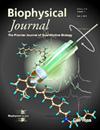Functional asymmetry in processivity clamp proteins.
IF 3.2
3区 生物学
Q2 BIOPHYSICS
引用次数: 0
Abstract
Symmetric homo-oligomeric proteins comprising multiple copies of identical subunits are abundant in all domains of life. To fulfill their biological function, these complexes undergo conformational changes, binding events, or post-translational modifications leading to loss of symmetry. Processivity clamp proteins that encircle DNA and play multiple roles in DNA replication and repair are archetypical homo-oligomeric symmetric protein complexes. The symmetrical nature of processivity clamps enables simultaneous interactions with multiple protein binding partners; such interactions result in asymmetric changes that facilitate the transition between clamp loading and DNA replication, and between DNA replication and repair. The ring-shaped processivity clamps are opened and loaded onto DNA by clamp-loader complexes via asymmetric intermediates with one of the intermonomer interfaces disrupted, undergo spontaneous opening events, and bind heterogeneous partners. Eukaryotic clamp proteins are subject to ubiquitylation, SUMOylation, and acetylation affecting their biological functions. There is increasing evidence of the functional asymmetry of the processivity clamp proteins from structural, biophysical, and computational studies. Here, we review the symmetry and asymmetry of processivity clamps and their roles in regulating the various functions of the clamps.加工钳蛋白的功能不对称。
由相同亚基的多个拷贝组成的对称同质寡聚蛋白在生命的所有领域都很丰富。为了实现其生物学功能,这些复合物经历构象变化、结合事件或翻译后修饰导致对称性丧失。围绕DNA并在DNA复制和修复中发挥多种作用的Processivity clamp蛋白是典型的同质寡聚对称蛋白复合物。加工钳的对称特性使其能够同时与多个蛋白质结合伙伴相互作用;这种相互作用导致不对称变化,促进了夹片加载和DNA复制之间以及DNA复制和修复之间的过渡。环形加工钳通过不对称中间体打开并装载到DNA上,其中一个单体间界面被破坏,经历自发打开事件,并结合异质伴侣。真核箝位蛋白受到泛素化,sumo化和乙酰化影响其生物学功能。从结构、生物物理和计算研究中,越来越多的证据表明,加工钳蛋白的功能不对称。本文综述了加工钳的对称性和非对称性及其在调节加工钳各种功能中的作用。
本文章由计算机程序翻译,如有差异,请以英文原文为准。
求助全文
约1分钟内获得全文
求助全文
来源期刊

Biophysical journal
生物-生物物理
CiteScore
6.10
自引率
5.90%
发文量
3090
审稿时长
2 months
期刊介绍:
BJ publishes original articles, letters, and perspectives on important problems in modern biophysics. The papers should be written so as to be of interest to a broad community of biophysicists. BJ welcomes experimental studies that employ quantitative physical approaches for the study of biological systems, including or spanning scales from molecule to whole organism. Experimental studies of a purely descriptive or phenomenological nature, with no theoretical or mechanistic underpinning, are not appropriate for publication in BJ. Theoretical studies should offer new insights into the understanding ofexperimental results or suggest new experimentally testable hypotheses. Articles reporting significant methodological or technological advances, which have potential to open new areas of biophysical investigation, are also suitable for publication in BJ. Papers describing improvements in accuracy or speed of existing methods or extra detail within methods described previously are not suitable for BJ.
 求助内容:
求助内容: 应助结果提醒方式:
应助结果提醒方式:


